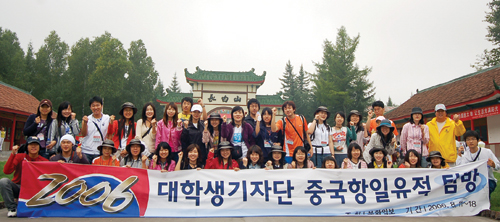
I took part in this investigation team as a cub-reporter of The Yeungnam Observer. I fluttered with anticipation of my first trip abroad, while looking forward to collecting historical data with other university reporters and incumbent journalists. This trip was a wonderful experience that lived up to my expectations.
For Korean patriots, China was a base for independent movement during Japanese colonial rule because independent movement was impossible within the Korea peninsula. I was so surprised to see so many anti-Japanese relics in China.
The first destination of our investigation team was Chungking. Chungking is the place where the Korean provisional government buildings were established. In Chungking, we visited the provisional government buildings of Yeonhwaji and Osayahang. The provisional government building of Yeonhwaji was established in 1940 as the last provisional government. This place seemed to have been well preserved. By contrast, the provisional government building of Osayahang, which was the third provisional government in Chungking, has no traces except for a single monument.

Subsequently, our team went on to explore Yenbyun. Yenbyun is an autonomous region of Korean Chinese who originally immigrated from Korea during Japanese colonial rule. I was glad to see many Korean signboards on the streets of Yenbyun. At Longjing which is located about 30km away from Yenbyun, we visited the birthplace of the poet Yun Dong-ju, his memorial hall, and the Hangeul Library among others. I was told that the Hangeul Library is the only library housing Korean books in China. We did not hesitate to donate Korean books which we carried with us, hoping the books will become a source of mollifying nostalgia for the Korean Chinese living in Longjing.

Indeed, Cheonji was breath-takingly beautiful, but I noticed that its edges were seriously polluted by many tourists. So I felt sorry about that and hoped to see the clearer Cheonji the next time.
After climbing up Mt. Backdu, we further went to the border between China and North Korea. We could watch some parts of North Korea over the bridge. Although we stood very close to North Korea, we couldn't go there. I was so depressed about the division of the Korea peninsula.
Then we went to see the ruined castle of Balhae which is located at Dungsingchung. Since the ruined castle of Balhae has emerged as a sensitive place politically, we were not allowed to shoot a video camera. I got angry at the signpost which reads: "Balhae was under the Tang Dynasty". I have learnt that Balhae is clearly a sovereign nation founded by our ancestors. It has nothing to do with the Tang Dynasty. It was founded by our own forefathers. I thought that the Chinese should know correctly about Balhae from the historical viewpoints.

At our last night in China, we produced our own newspaper carrying various articles about our trip to Korean historical remains in China. To me, it was a very meaningful time. Meanwhile I felt sad because we had to say farewell to each other soon.
Although our exploration into the past did not last long, this trip was a wonderful gift for me because it gave me precious memories as well as an ardent love for our country. Thanks to independent fighters who sacrificed themselves for Korea's independence in a far-off foreign country, eventually we could call our nation by its name Korea.
I hope that this article will not lead our readers to a unfamiliar history.
It was such a wonderful trip!!
저작권자 © 영남대학교 언론출판문화원 무단전재 및 재배포 금지


